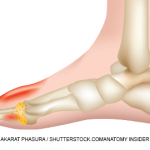SAN DIEGO—If patients with gout keep their serum urate (SU) levels very low with urate-lowering therapy (ULT), they have fewer flares, according to a research abstract presented at ACR Convergence 2023.1 Sara K. Tedeschi, MD, MPH, assistant professor of medicine at Harvard Medical School and rheumatology director at Brigham and Women’s Hospital, Boston, and colleagues concluded that gout flare rates were persistently higher when SU was ≥6 mg/dL compared with SU at target after the first year of urate lowering therapy. According to the researchers, these data suggest a potential benefit of achieving very low SU levels (≤3.9 mg/dL) and consideration of a longer duration of prophylaxis to reduce gout flares.
The 2020 ACR Guideline for the Management of Gout recommends a target SU of <6 mg/dL and anti-inflammatory flare prophylaxis for at least three to six months after initiating ULT. Tedeschi et al. investigated gout flare rates based on repeated measurements of SU levels in a randomized controlled trial of ULT, accounting for loss to follow up, with the intention of identifying optimal SU targets.
According to the abstract, the researchers performed a secondary analysis using data from the Cardiovascular Safety of Febuxostat or Allopurinol in Patients with Gout (CARES) trial. CARES participants were randomized to febuxostat or allopurinol, titrated for a target SU <6 mg/dL; 45% did not complete all study visits. Participants received gout flare prophylaxis for six months with 0.6 mg if colchicine daily or 250 mg of naproxen twice daily if they could not tolerate colchicine.
For this analysis, participants were followed from month 0 (randomization) to the earliest of death, last completed visit (drop out), or end of study. SU levels were assessed at months 0, 3, 6 and then every six months and categorized as ≤3.9, 4.0–5.9, 6.0–7.9, 8.0–9.9 and ≥10 mg/dL. The primary outcome was self-reported gout flare in each three- or six-month interval. More than one flare/interval was permitted if they were separated by ≥14 days. Baseline variables were used to derive inverse probability of censoring weights (IPCW) to account for censoring (drop-out or death). Poisson regression models included stabilized IPCW weights and estimated gout flare incidence rate ratios (IRR) by time-varying SU category, adjusting for change in SU from prior visit, flare prophylaxis, ULT, age, sex, race, body mass index, gout duration,and tophi. Models were performed for months 0–6, 6–12 and 12–72.
Of the 6,183 participants in this analysis, the median age was 65 (IQR 58–71) years and 84.0% were men. The median follow-up was 32 months.
Results
At month 0, the median SU was 8.6 (IQR 7.6–9.7) mg/dL. Seventy-one percent achieved an SU of <6 mg/dL by month 3, and this percentage increased slightly over time among retained participants. Gout flare rates were highest during nearly all intervals when SU ≥10 mg/dL and lowest when SU ≤3.9 mg/dL. Peak gout flare rates for all SU categories were observed between months 0 and 3, coinciding with the initiation of ULT and greatest change in SU. A second spike in gout flares occurred in all SU groups between months 6 and 12, coinciding with discontinuation of prophylaxis. In the initial year of ULT, flare rates did not significantly differ between SU groups, but flare rates were consistently highest when SU was ≥10 mg/dL. During months 12–72, in adjusted analyses with IPCW weights, a dose-response relationship was observed between SU category and flare rate. Compared with SU 4.0–5.9 mg/dL, significantly lower flare rates were observed when SU was ≤3.9 mg/dL and significantly greater rates when SU was ≥10 mg/dL (P for trend <0.01).
Conclusion
In short, when patients had a lower SU, their chances of flare decreased significantly. Clinicians may want to consider extending the length of time their patients remain on prophylaxis to minimize flares.
Editor’s note: For details and to review all figures, references and disclosures, refer to the full abstract.
Reference
- Tedeschi S, Hayashi K, Zhang Y, Choi H, Solomon D. Identifying optimal serum urate levels to reduce gout flares in patients taking urate lowering therapy: A post-hoc cohort analysis of CARES with consideration of drop-out [abstract]. Arthritis Rheumatol. 2023;75(suppl 9).



